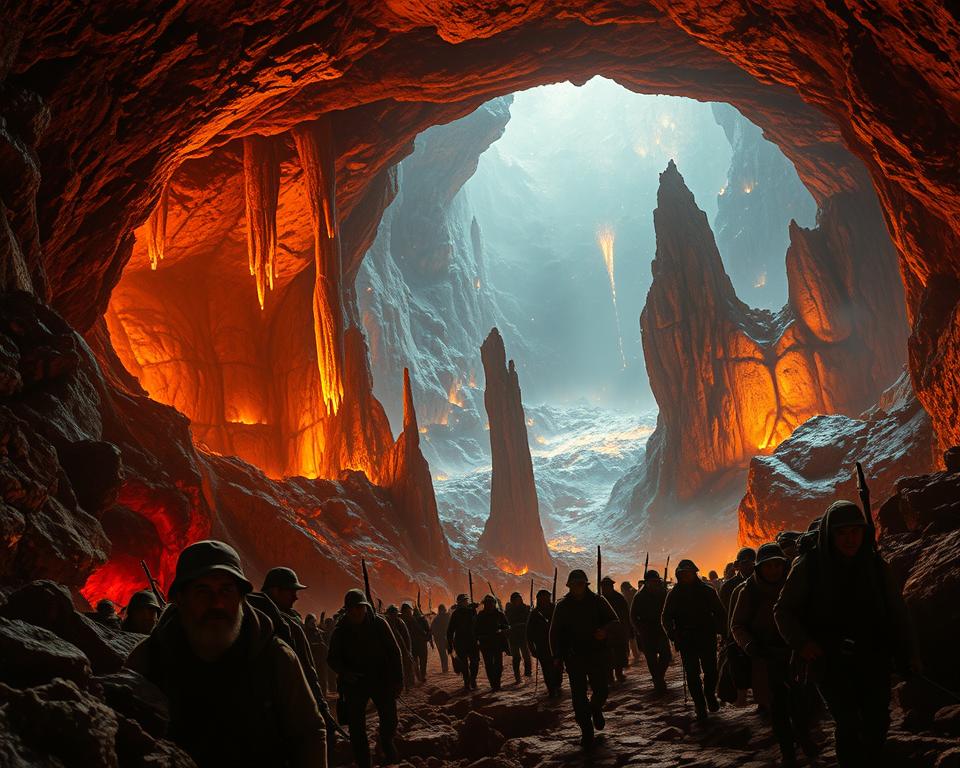In 1864, Jules Verne’s Journey to the Centre of the Earth was a big hit in adventure novels. This French classic tells the story of Professor Otto Lidenbrock, his nephew Axel, and guide Hans Bjelke. They follow a 16th-century alchemist’s map found in an old manuscript.
Their journey takes them into Iceland’s Snæfellsjökull volcano. There, they meet 12-foot creatures, flammable gas, and even mastodon herds. After a close call with a rockslide, they use dynamite to clear their path. They then escape via Stromboli’s eruption, mixing real science with fantasy.
This article dives into how Verne’s 1863-inspired tale has become a key part of science fiction’s history.
Key Takeaways
- Published in 1864, this adventure novel merges 19th-century geology with daring fictional expeditions.
- Three explorers face perilous conditions, including flammable gas and a 100% dead-end route forcing a retreat.
- Features prehistoric ecosystems like Tertiary-period forests and ichthyosaur battles.
- Uses dynamite to trigger an underwater eruption, ejecting the team to Stromboli.
- Based on a decoded 16th-century message from alchemist Arne Saknusscem, it pioneered sci-fi’s fusion of fact and fiction.
Introduction to Jules Verne’s Groundbreaking Novel
I start by looking at how Jules Verne changed storytelling with his 1864 book, Journey to the Centre of the Earth. This novel, part of his Voyages extraordinaires series, mixed science with adventure. It set the stage for today’s science fiction.
Verne was born in Nantes, France, in 1828. He married Honorine in 1857, which helped him focus on writing. He wrote over 60 novels that are key in classic literature.

I talk about important moments in his career. His work with Pierre-Jules Hetzel made the series a hit. His books have been translated into over 140 languages.
Books like Twenty Thousand Leagues Under the Seas and Around the World in Eighty Days keep inspiring people. The USS Nautilus submarine, named after his 1870 book, shows his impact on technology.
His stories, based on 19th-century science, predicted things like submarines and space travel. The 1954 film of Twenty Thousand Leagues and the 2005 UNESCO “Jules Verne Year” in France honor him. His work connects dreams with reality, making him a key figure in science fiction and classic literature.
The Literary Significance of Journey to the Centre of the Earth
I look into how Jules Verne changed storytelling by mixing science with adventure. Born in 1828, he started science fiction with Journey to the Centre of the Earth. This book is a key part of classic literature.
His stories combined real science, like 19th-century geology, with exciting plots. This set a new path for writers to follow.

- His detailed research made far-off ideas seem real, like underground oceans and lost species.
- He inspired many, earning him the nickname “Father of Science Fiction” alongside H.G. Wells.
- Journey to the Centre of the Earth is a 227-page journey of his imagination, published in 1864 as part of the Voyagers Extraordinaire series.
Verne’s impact is seen in schools and sci-fi movies. His stories, rated 4/5 stars, show why classic literature is important. By using science in his tales, he opened doors to learning about Earth and our future.
Publication History and Early Reception
When Journey to the Centre of the Earth first came out in 1864, it was a big deal for Jules Verne. The Paris-based J. Hetzel et Cie published the first French edition. Later, in 1867, they added scenes of prehistoric battles like the Ichthyosaurus vs. Plesiosaurus fight.
By 1871, Griffith & Farran’s English version changed some names and added chapter titles. These changes weren’t in Verne’s original book.
Early readers were drawn into a world where science and fiction mixed. Critics loved its creativity, but geologists didn’t buy the underground adventures. This mix of fact and fantasy became a key part of Verne’s work.
- 1864 French debut with 45 chapters and 233 pages
- 1867 revision expanded prehistoric scenes
- 1871 English edition’s altered character names
- Penguin Classics’ 2008 edition features Jane Smiley’s analysis
Translations changed the story’s shape, but the main idea stayed the same. Today, this 19th-century book is a key part of science fiction’s history. It shows how choices in the 1860s helped shape its lasting impact.
What is the Summary of Journey to the Centre of the Earth?
My journey to understand what is the summary of journey to the centre of the earth? starts with Axel leaving Hamburg with his uncle, Prof. Lidenbrock. They head to Iceland, the first step to the Earth’s core. After figuring out Arne Saknusemm’s clues, Prof. Lidenbrock wants to follow the alchemist’s path. Axel is unsure but joins him on a steamship to Reykjavík, Iceland’s capital. They hire Hans Bjelke, an Icelandic guide, for his knowledge and calmness.
In Iceland, they aim for Snæfellsjökull, the volcano from Saknusemm’s note. They face tough weather and paths, showing Axel’s worries. Prof. Lidenbrock’s drive keeps them going, even with Axel’s doubts. They see a glacier-covered volcano and find clues of ancient life. This part of their adventure prepares them for going deeper into the Earth.
- Prof. Lidenbrock sticks to Saknusemm’s map, ignoring modern science.
- Axel writes about his fears and thoughts, adding a personal touch.
- Hans’s calm helps them on their Icelandic journey.
The trip to Iceland is more than just a journey. It’s Axel’s move from doubt to explorer. Verne mixes real places like Snæfellsjökull with fiction, building suspense. This part shows the battle between curiosity and danger, a key theme of the novel.
Descent Through Snæfellsjökull
Prof. Lidenbrock’s team bravely tackles the icelandic volcano’s icy slopes. They rappel into Snæfellsjökull’s crater, a 5,000-foot dormant giant. Verne’s research mixes Iceland’s volcanic history with fictional elements.
The glacier is 650 feet deep with complex tunnels. Prof. Lidenbrock’s tools show mineral veins and fossilized shells, surprising 19th-century science. A wrong turn almost traps them, but Hans leads them safely deeper.
The volcano’s 700,000-year-old core holds secrets. These secrets challenge their survival.
Subterranean Marvels and Prehistoric Encounters
They find glowing quartz and ancient lava tubes. Prehistoric forests and a subterranean ocean reveal unseen worlds. The prof. lidenbrock’s obsession grows as they face a primordial ocean and a glowing cavern.
Verne’s story blends Iceland’s volcanic features with fiction. The journey’s tension builds as they face a 75-mile trek from Reykjavík. Each discovery shows the battle between science and imagination.
The Dramatic Escape and Return to the Surface
In the adventure novel’s climax, Axel and Prof. Lidenbrock face a volcanic chimney. This leads them to Stromboli’s surface. Their dangerous climb ends their underground journey, mixing risk with discovery.
Main Characters and Their Development Throughout the Story
Here’s how their journey reshaped each protagonist:
- Axel’s Courage: Starting as a hesitant scholar, he becomes a decisive survivor. His transformation embodies resilience central to the adventure novel’s narrative.
- Prof. Lidenbrock’s Triumph: His relentless drive secures him scientific acclaim, cementing his legacy as an explorer.
- Hans’ Resolve: Returns to Iceland, his quiet loyalty contrasts the others’ dramatic changes.
I analyze Axel’s marriage and Prof. Lidenbrock’s recognition as defining outcomes. Their return shows how this adventure novel blends character growth with scientific ambition. It offers readers a tale of perseverance and discovery.
The Scientific Context Behind Verne’s Imaginative Vision
To understand “Journey to the Centre of the Earth,” we must look at 19th-century science. Jules Verne’s 1864 novel was inspired by the groundbreaking discoveries in geology and paleontology. These changes reshaped how people saw Earth’s past.
19th Century Geological Theories
Verne’s science fiction was shaped by several key ideas:
- Lyell’s uniformitarianism: Charles Lyell’s theories on gradual geological change
- Darwin’s evolutionary ideas post-1859
- Hypotheses of a hollow Earth with vast underground cavities
Jules Verne mixed these theories with adventure. His characters found geothermal vents and prehistoric creatures. This showed the debates over Earth’s structure back then.
Even though we now know there are no subterranean oceans, Verne’s story was rooted in the optimism of the 1860s. The contrast between 19th-century curiosity and today’s knowledge shows how science fiction grows with new discoveries.
How Modern Science Views Verne’s Speculations
Modern geology has debunked Jules Verne’s subterranean journey idea. Yet, his stories continue to captivate us. Scientists now know Earth’s core is a scorching 6,700°F, making human survival impossible. This proves Verne’s novel was not meant to be taken literally.
But Verne’s impact on science fiction is undeniable. He mixed real science from the 19th century with exciting stories. This blend has inspired countless authors and scientists.
The Blending of Fact and Fiction
Verne based his stories on the latest research of his time. His Journey to the Centre of the earth used theories by Humphry Davy and geological layers from 1864. He even included dinosaurs and prehistoric humans, despite knowing they lived long before humans.
Verne’s approach was to use science fiction to spark curiosity and share knowledge. His stories were a mix of fact and fiction, aiming to inspire and educate.
- Geologists today reject the novel’s literal subterranean ecosystems
- Verne’s “prehistoric realms” inspired tropes like Arthur Conan Doyle’s The Lost World
- Modern science confirms Earth’s core is a molten-metal forge, not a habitable underworld
Verne’s true genius was in pioneering storytelling. His 1864 novel, Journey to the Centre of the earth, used real science to make the impossible seem possible. Though it was scientifically incorrect, it laid the groundwork for sci-fi.
Today, readers are amazed by Verne’s ability to merge 19th-century science with imagination. This fusion has shaped the genre, inspiring countless authors and scientists.
Analyzing the Icelandic Volcano as the Gateway to Adventure
Jules Verne’s use of the icelandic volcano, the real-world Snæfellsjökull, connects fiction to reality. This dormant stratovolcano on Iceland’s Snæfellsnes Peninsula is the heart of the adventure. Its glacier-capped peak and mythical status in local lore make it a perfect setting for a story that mixes science and mysticism.
- Verne’s research noted its unique geology: a 4,744-foot mountain with a glacier despite its volcanic base.
- Icelandic legends of hidden worlds beneath Snæfellsjökull align with the novel’s premise of secret underground realms.
- Historical figures like Arne Saknusemm’s alchemical theories add layers of authenticity to the narrative.
Snæfellsjökull: The Real Location
Today, this icelandic volcano is a pilgrimage site for fans of the adventure novel. Its trails and lava fields mirror the fictional descent described in 1864. Travelers now hike its slopes, tracing paths once imagined by Verne. Nobel Prize-winning author Halldór Laxness later used the area’s mystique in his novel Under the Glacier, deepening its literary legacy.
The subterranean journey in the story mirrors 19th-century geological debates about Earth’s core. While the volcano’s actual geology differs from the tale’s fantasy, its real-world presence proves how fiction can transform landscapes into cultural landmarks. Exploring Snæfellsjökull today means walking between reality and the pages of a timeless adventure novel.
Symbolic Significance of the Volcanic Entrance
I explore how the volcanic entrance shows humanity’s endless curiosity. It opens a path into the earth, much like ancient myths like Dante’s *Inferno*. It mixes classic literature with 19th-century science dreams. The journey down Snæfellsjökull is a symbol of exploring beyond what we know.
The Subterranean World: Fantastical Elements and Descriptions
Verne’s world is full of imagination. Explorers enter a bright world with a sea named Lidenbrock, filled with storms and glowing lights. Nature surprises us with giant mushrooms, swimming dinosaurs, and a huge human-like creature with mastodons. This mix of science and fantasy makes the journey below ground feel like a dream.
- Aurora-like light lights up storms above the Lidenbrock Sea.
- Prehistoric creatures fight in vast waters, showing Earth’s hidden past.
- A 12-foot humanoid figure suggests there might be more species, challenging our views.
Verne’s stories thrill us while making us think about science. The journey ends with an eruption, showing the power of nature. This underground world is a timeless symbol of the adventure and danger of exploring.
Literary Themes and Motifs in Journey to the Centre of the Earth
Jules Verne’s “Journey to the Centre of the Earth” is a classic that explores human curiosity and ambition. It combines deep research with creative ideas, making it a key work in science fiction. This book has inspired over 54 works in Verne’s “Voyages extraordinaires” series and has been adapted into 11 films, including a 1959 and a 2008 3D version.
The Quest for Knowledge
The story shows our drive for discovery and the risks of too much ambition. Professor Lidenbrock’s quest for knowledge is fueled by a 16th-century alchemist’s clues. This journey through a volcano shows how science and fiction blend.
Verne’s work is special because it mixes adventure with deep questions. Axel’s journey from a shy student to a brave explorer reflects how we see nature changing. The prehistoric creatures he meets remind us of our small role in Earth’s history.
Even today, the book’s themes of never giving up and thinking about the right thing to do are important. It has been translated into 2022 languages, showing its lasting impact. Verne’s vision has stood the test of time, reaching beyond its Victorian origins.




